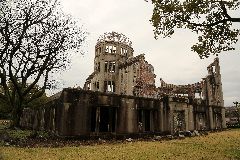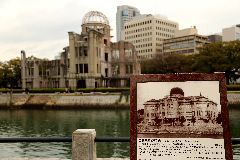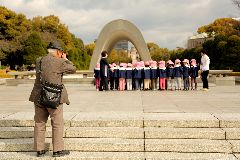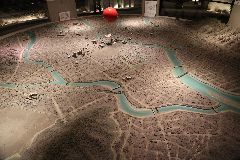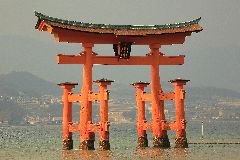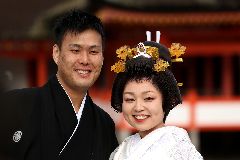You've heard about this place: Hiroshima
Hiroshima and the story behind the first atomic bombing in history. Very disturbing reading indeed. Miyajima's floating tori gate as bonus
As my time in Japan was severely squeezed, I had to give up plans of venturing away from Kansai (region around) Kyoto and Tokyo, but I didn’t want to give up my plan to visit Hiroshima.
And so I did a day trip from to Hiroshima to Kyoto. It’s almost 400km one way, making it a day trip of some 800km. Covering such a distance would probably take a week in India, but in Japan, thanks to levitating Shinkasen “bullet trains” this is perfectly doable in one day. Soon after leaving Kyoto the train was flying (literally) faster than 300km per hour, and made it to Kyoto in 2 hours 45 minutes, including all the stops. When the Shinkansen reaches it full speed, it feels bit weird at first – everything closer than 100m is completely blurred by the fast motion– but it doesn’t take too long to get used it, and later I could hardly realize that the train was going 3 times faster than trains in Slovakia. Shinkansens have even smoking cabins, and of course I did not miss a chance to puff one bidi at 300kmh.
If you expect Hiroshima to be some radioactive, still semi-destroyed gloomy place, you are wrong. This still is modern, heavily populated city, and wouldn’t it be for what was intentionally left to remind the first atomic bombing in the history, you would have never thought that it had happened here. Truth be told, I didn’t find it particularly beautiful town. It’s modern, but rather dull. At least so it seemed to me during my 4 hours visit there, which is very superficial of course. I headed straight to the Atomic Dome, the famous ruin of a building, which was among very few buildings which survived the atomic bombing on 6.8.1945 (still 5.8.2014 American time). The reason why its torso survived seems quite paradoxical at first – it was right in the epicenter of the nuclear explosion. But knowing all the details, it actually makes perfect sense. The point here is, that the bomb did not explode on ground level. To create more destruction, it was detonated some 600m above ground level, right above the Atomic Dome. Back then this building was something like a business center, and it was designed by a Czech architect. Unlike most of the buildings in Hiroshima it was constructed of concrete. And as the bomb exploded right above it, the force coming from the explosion was almost purely vertical – pushing down. Of course all the glass and weaker elements of the building were shattered, but the mass of concrete walls being push down managed to survive the explosion, while walls of other buildings all crumbled, as the force was much more horizontal and this blew the walls down everywhere else.
Atomic Dome is the only building (more precisely leftovers of a building) which remains in Hiroshima since that day.
Next to it is Peace Park. It used to be a neighborhood that was chosen by Americans as the target explosion site, and was destroyed to ashes. Instead of building a new houses and infrastructure the Japanese decided to keep this place as a reminder of the destruction brought by Little Boy (code name of the atomic bomb thrown onto Hiroshima) and now it’s a park housing Atomic Bomb Museum and memorials. One of the memorials is cenotaph which is basically a big stone sarcophagus with list of all people who died because of the a-bomb inside. Around 140 000 names are kept inside.
Apart from the obvious topic of destiny of Hiroshima, Atomic Bomb Museum covers the topic of discovery, usage and proliferation of nuclear weapons. There are photographs, miniature models of Hiroshima, and leftovers of things and people (yes, also of people) that were destroyed and killed during or after the explosion, which claimed some 140 000 lives. While some of the photograph were tough stuff, Japanese decided not to make the museum a horror show, and so I can say that the Vietnam War Museum in Ho Chi Minh City (Saigon) remains by far the most horrifying museum I’ve seen. Hiroshima didn’t come even close to its raw, brutal, heart breaking horrors.
For me the most interesting part of the museum was unclassified documentation of American scientists and politicians regarding the development of nuclear weapons and planning its first usage. While the decisions are all understandable from viewpoint of world politics of those times, the cold blooded calculations behind this story are shocking. I cannot reproduce the whole story here, but let me share some “highlights”.
American program to develop a nuclear weapon was started after a nuclear scientist Leo Szilard informed US Government that based on latest discoveries in physics possibility of construction of new, incomparably destructive weapon seems to be almost certain and that German scientist have started working on it. Pointing out that USA has no other option that to outrun the Germans in this race he requested that US Government starts a project, which later became to be known as Manhattan Project. To add authority to the letter to the US government (underlining its urgency, importance and feasibility of construction of the weapon) it was signed by Albert Einstein.
Now let’s get to the cold calculus of death and war. Americans and British decided that atomic bomb, once that it would be developed, should be thrown on Japan. As the memorandum stated, if the bomb would be thrown on Germany, the Germans, who were known to be working on the bomb, might be able to figure out something from its explosion and it might get them closer to developing their own weapon. Japan, being technologically much less advanced, was thought to be a safer option. This was in 1941, 4 years before the bomb was developed. Finally the historic circumstances didn’t even allow bombing Germany, as until the bomb was ready the Germans had capitulated, so will never know what would be the final decision if it would be otherwise. The fact is that American and British had chosen their perfect target long before they even had nuclear weapon.
Cold calculus of death continues. Americans, being close to developing functional atomic bomb, started to look for a target city. As far as I remember, some 24 Japanese cities were pre-selected. And now let’s get cold. The war was about to finish, and most of Japan was under heavy aerial bombardment of US Air Force. As one of the memos stated “US Air Force is so successful in bombing Japan, that if they don’t stop, there will be nothing left in Japan to see the power of the new bomb”. And so, with immediate order, the preselected 24 cities were taken off the list of conventional aerial bombardment, in order to keep enough infrastructure standing to see how destructive the atomic bomb would be. The list was shortened and shorted, until 3 cities remained as the final candidates: Hiroshima, Kokura, Nagasaki. They key to their selection was presence of military industry, army facilities and being large enough, populated enough and flat enough to show all the strength of the bomb. I’m sure that the Japanese were wondering why suddenly bombing of all those cities stopped – if they only knew…
In was during this final stage of planning when, according to the memos, some American scientists who were working on Project Manhattan suggested that instead of bombing a Japanese city, the Japanese army leaders should be told that USA had developed a new kind of weapon and to make a demonstration of its power by throwing it on uninhabited island. One of the scientists argued something like this: “The war will soon be over, and we - the Americans – should not outdo the Germans in its worse atrocities”. Another one: “The physical principles behind this bomb are generally known and accessible. We can consider it a fact that not long after we develop the bomb, other countries will follow. To prevent a total destruction of human race by usage of these weapons, the world will have to agree on limitations of their usage. If we – the Americans – become the first ones to use it, it will be impossible for us to be leaders of such international community, and we will have no political and moral power to ask for control of these weapons”. But it was not the scientists who had the final word, it was the politicians. Every displayed memo started like this: “Budget: 800 million dollars have been spent so far”. The first and foremost matter of development of nuclear weapons was budget. Just like on every IT project I have worked on. While some scientists called for showing the strength of the bomb to the world without killing tens of thousands of people, the arguing of the politicians was just the opposite. The final recorded spending of Manhattan Project was 2 billion dollars. In 1940’s that was tremendous amount of money. One of the politicians was cited in memos: “Gentlemen, we have spent 2 billion dollars of American tax payers on this weapon. Once the war is over, how are we going to justify this spending to the people if we don’t use the weapon?”. Basically the point was that for so much money spent, they definitely have to kill someone. But the cold calculus of death and war went forward. The Americans knew that the war will be over soon and that Japanese will lose. The Japanese knew it as well. And also the Russians. The reason why Japan didn’t capitulate to USA was that in 1945 it had still neutral relationships with Soviet Union, and the Japanese were hoping that maybe Soviet Union can intervene to help them to bargain better capitulation conditions with USA than what USA had offered so far. It was known that the crucial condition of Japanese capitulation was guaranteeing continuity of the Japanese emperor dynasty. Americans knew that if Soviet Union will get involved in the war against Japan and will help to defeat the Japanese, Soviet future influence over Asian-Pacific region will rise. That is something that American didn’t want to happen at all. USA had to defeat Japan quickly and without Soviet help. Knowing all of this, it will not surprise you that the final decision to throw atomic bomb on Japan was taken immediately after Stalin declared war on Japan. Again, contrary to the suggestions of the scientists, in the capitulation conditions which US Government delivered to the Japanese one day before the bombing, the guaranteeing of continuity of the emperor dynasty and any acknowledgement of having a new weapon were left out. Basically the US did deliver the request for capitulation before the bombing, just to wash its hand clean, but did everything to prevent the “risk” that the Japanese would accept it and thus would spoil their great experiment.
Shortly before the final bombing, the US Air Force dropped around 40 fake nuclear weapons as a practice for their pilots, because the proportions and weight of the nuclear bomb were different from conventional bombs, so the pilots had to make a rehearsal. Apart from that, just before the bombing the Americans threw various devices for measurement of the impacts of the atomic bomb all around Hiroshima, so that later they could precisely study the pressure, temperature and radioactivity caused by the bomb. All it all, this was one huge political, military and scientific experiments, rather than means for ending the war as such.
The scientific experiment continued 3 days later in Nagasaki. The Hiroshima bomb was made of uranium, the Nagasaki bomb was made of plutonium. Both worked as intended. After seeing that Americans can rain atomic bombs onto Japan for as long as necessary, the Japanese agreed with unconditional surrender.
The Americans did finally not request abdication of the emperor dynasty. The main condition which prevented Japanese from former surrender was met, but only after the Americans tested their new weapons.
As you can see from photos in the photo gallery, Hiroshima was turned to ashes. But the reconstruction of the city started immediately and Hiroshima recovered. If you fear that Hiroshima must be still radioactive city not suitable for living, well the museum claimed that due to exponential rate of diminishing of radioactivity (basically the radioactive material split up to lighter elements or was consumed by other materials) the radioactivity in Hiroshima was not different from any other city in the world just after 1 week. But during this week tens or hundreds of thousands of people were already exposed to deadly amounts of radiation and the aftermath of the bombing lasted years and years, with people dying and suffering horrible consequences of exposure to radiation long after the war had ended.
One more interesting thing, this time about Nagasaki. The original target for the second atomic bomb was city of Kokura but due to bad weather the airplanes finally dropped the bomb on secondary target – Nagasaki. As pointed out in Czech film “Knoflikari”, sometimes bad weather can save your life. Was it also interesting that during Japan’s seclusion from rest of the world, there was only one city in Japan that was allowed to communicate and trade with the western civilizations. Guess which one! Nagasaki. For centuries, Nagasaki was the western gate to Japan and as a result, Nagasaki had a sizeable Christian population (some say biggest Christian population in Asia) by the time of the bombing. The second nuclear bomb exploded right above the largest Christian temple in Asia. Very eloquent final word in relationship between western civilizations and Japan. Maybe Japan’s emperors should have never opened the port in Nagasaki…
From the further information about nuclear weapons, one interesting was that the strongest nuclear weapon ever tested was a Soviet hydrogen bomb. Its power equaled to 3 000 Hiroshima bombs and 10 times the combined power of all conventional weapons used during world war two. I wonder what did Soviets actually want to do with such a bomb. Destroy everything between New York and Chicago by a single bomb?
Disclaimer: This is not a diploma thesis on nuclear weapons or history of Hiroshima. I did not bother to check these things, I’m just reproducing what I had read in Hiroshima and how I remember it.
It was brutal reading in Hiroshima and the cold pragmatic attitude to killing hundreds of thousands of people is tough to process. But the hardest thing to process is the fact, that from my own perspective, and probably from perspective of mankind as well, we should be sort of “glad” it has happened. I don’t believe that US and Soviet politicians would resist the temptation to try their nuclear “toys” later during the cold war, if the world hadn’t seen their impact in Hiroshima and Nagasaki. And consequences of nuclear conflict in cold war era would be incomparably more devastating, especially for us living in the Central Europe, than Hiroshima and Nagasaki. We all might be dead by now (or never born). Including you. Those poor Japanese people paid the most horrible price to save the rest of us. Something like Jesus had done... Amen.
Since I had still some time left after I finished atomic sightseeing in Hiroshima, on my way bak to Tokyo I did a side trip to Miyajima. It’s a sacred Shinto island with famous “floating tori” (tori is a typical Shinto gate). It took some 20 minutes by boat to reach it, then I walked around, took some photos, rang some holy Shinto bells, ate few oysters – local specialty – took the boat back to the mainland and caught Shinkansen back to Kyoto. And that’s all folks.
